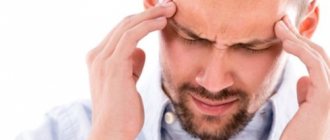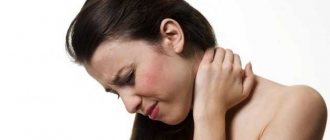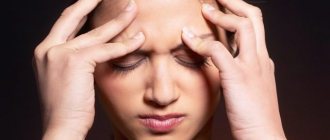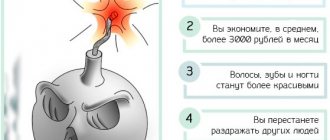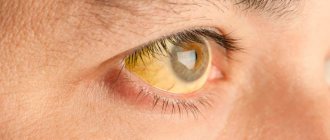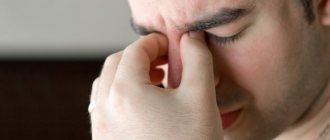The lucky ones who have never experienced a headache are certainly enviable. It's a pity that these days it's almost impossible to find them. Most people know firsthand what pressing, bursting, sharp or pulsating pain is, appearing suddenly and making life unbearable. Most often they are localized in the forehead area. Their character is completely different. But in any case, the sensations that a person experiences cannot be classified as pleasant. In order not to ruin your life and not to constantly be tormented by the question of how to overcome pain, you just need to determine the cause of this problem and begin to treat it.
Types of pain!
Why does my head hurt in the forehead area?
Head pain can cause many diseases. However, in order not to go into unnecessary details, we can roughly divide all the reasons into five types:
- Intoxication of the body. Poisoning can be caused by both food and air pollutants.
- Viral and infectious diseases. For example, sinusitis, acute respiratory infections, flu.
- Head injuries. Especially if they led to a concussion. Neck injuries are also a risk.
- Diseases associated with the nervous system, such as migraines, neuroses, neuralgia.
- Disturbances in the functioning of the heart and blood vessels. Such diseases are often characterized by cerebral vascular spasms and intracranial pressure. And these problems are constant companions of headaches.
Headache in the forehead caused by intoxication of the body
Many people have not even heard about the presence of chemical products harmful to humans in the environment. Although today this problem has become very relevant. It appeared as a result of an oversaturation of the market with low-quality goods containing harmful and sometimes dangerous substances that can enter the air and cause intoxication of the body.
You should be wary of cheap children's toys, low-quality dyes, cheap plastic and other synthetic substances.
In addition, low-quality food products containing harmful chemical additives can lead to intoxication of the body. Pain in the frontal part of the head can be caused by nitrates, which are often present in overseas fruits and vegetables, and various synthetic additives. Tyramine, a substance found in completely harmless foods such as nuts, chocolate, and some types of cheese, often causes pain in the forehead. Caffeine is also an essential attribute of coffee and energy drinks. Drinks, according to manufacturers, that can energize you for the whole day. Therefore, if you know that you have intolerance to these foods, it is better to exclude them from your diet.
Conclusion
In addition to all of the above, headaches can occur due to ordinary fatigue, both moral and physical. To prevent headaches, it is very good to do regular exercises every day (you will need literally 10 minutes for this). Often, simple turns of the head from left to wrong and vice versa, up and down, help stretch the neck and wake up the brain. Spend at least 30-40 minutes outdoors every day.
If you still eat right, lead a healthy lifestyle, do physical exercise and still often suffer from headaches in the forehead area, then it’s still better not to delay this process by eating pills, but it’s better to turn to a general practitioner, and after examining the symptoms, he will refer you to an otolaryngologist or neurologist, and maybe to a dentist. Also, most likely (as often happens) you will be directed to undergo an MRI procedure, as well as an ultrasound of the vessels of the head.
It’s better not to joke with your health; frequent pain of this kind can be the first sign of a very serious illness!
Money can’t buy health, you just need to look after it and take care of it! Love yourself, pamper yourself and be sure to take care!
Pain in the forehead accompanying viral and infectious diseases
Any inflammation in the body is almost always accompanied by pressing, painful sensations in the forehead or slightly above. However, there are diseases for which a headache in the forehead is almost the main symptom. These include:
- Frontit.
- Sinusitis.
- Ethmoiditis.
With frontal sinusitis, inflammation occurs, localized just above the bridge of the nose. Depending on which sinus the inflammation is stronger in, pain may be felt on the left or right side. With this disease, a person suffers from a sharp, paroxysmal pain in the forehead area, which becomes stronger when bending forward. Painful sensations may intensify during sleep. Their intensity depends on the filling of the frontal sinuses with purulent contents. This disease is treated with antibiotics; it is advisable to start treatment at an early stage, since frontal sinusitis is very dangerous. It affects tissues close to the brain, so you should not neglect the treatment of this disease.
Sinusitis is a common disease. It is less dangerous than frontal fire. But it can also cause a lot of suffering. With this disease, pus accumulates in the maxillary sinuses, located in the area of the cheekbones and eye sockets. The pain almost always radiates to the eye sockets, on the left or right side and above – to the area of the bridge of the nose. The localization of pain depends on which sinuses are inflamed. For example, inflammation of the left maxillary sinus will lead to increased discomfort in the left side of the forehead. Sometimes inflammation of both sinuses is diagnosed, in which case a bursting headache in the frontal part will be observed on both sides.
Ethmoiditis is an inflammation of the ethmoid labyrinth or the so-called ethmoid sinuses, which are located deep in the skull. This disease can also be either unilateral or bilateral, that is, on the right and left sides. It often accompanies frontal sinusitis and sinusitis, but can also be present independently. In this case, a person is bothered by a headache in the area of the bridge of the nose, sometimes it can radiate a little higher.
All these diseases are viral in nature and appear as a result of improper treatment of flu or colds.
In addition, other infectious diseases accompanied by elevated temperature can lead to pain in the forehead area. As a rule, in this case, the pain in the forehead goes away after the temperature can be lowered.
Features of treatment
Therapy to help relieve pain depends on what is causing the discomfort.
- If your head hurts due to an infectious disease or an inflammatory process, it is necessary to cure the disease and take medications that reduce the temperature.
- To relieve a migraine attack, special medications are used: Sumamigren, Ergotamine, Triptane.
- A person whose headache is caused by a stroke needs urgent hospitalization.
- For osteochondrosis, in addition to medications, the doctor usually prescribes physiotherapeutic procedures: magnetic therapy, electrophoresis, massage sessions.
- If the pain is caused by a brain tumor, an oncologist or neurologist can provide qualified assistance by selecting a comprehensive treatment.
Attention! If a person suffers from pain of any kind, which manifests itself regularly, it is necessary to consult a doctor.
How to eliminate discomfort quickly?
What to do if a headache suddenly appears on the left side of your head? You can relieve the condition at home without taking pills.
- Drink warm tea with mint, chamomile, lemon balm.
- Take a cool shower.
- Tie a scarf on your head.
- Apply a compress, warm or cold, to the area of pain. Depending on what helps better.
A migraine attack will go away faster if you close the curtains in the room, ventilate the room, and avoid loud sounds.
Prevention
Sometimes discomfort torments a person due to an incorrect lifestyle. To reduce headaches, you need to:
- Stop smoking.
- Do not abuse alcohol.
- Eat a balanced diet: avoid foods containing trans fats, mayonnaise, and hot dogs. Eat fresh vegetables, fruits, natural dairy products, lean meat, sea fish, nuts.
- Go to bed before 23-00, sleep at least 8 hours a day.
- Take care of your teeth and visit the dentist regularly.
- Allow feasible physical activity: swimming, cycling, going to the skating rink, playing table tennis.
If a person has pain on the left side of his head due to constant stress, heavy responsible work, he needs not only to take antidepressants, but also to rest for a sufficient amount of time. Sometimes, to get rid of nerve pain, a person needs to visit a psychologist or get help from a psychotherapist.
What are the dangers of head injuries?
Very often, such injuries are subtle, so most people do not attach much importance to them. In some cases, indeed, there is no need for medical help. But there are several signs that will unmistakably indicate to you that you need to call a doctor immediately. These include:
- Increased body temperature.
- Cramps.
- Loss of consciousness.
- Blurred vision.
- Difficulty speaking.
- Vomiting or nausea.
Sometimes damage to the cervical vertebrae or an untreated concussion makes itself felt only after some time, so treating this problem as a trifle is, to say the least, dangerous.
Pain in the frontal part of the head is a companion to heart and vascular diseases
The most common cause of headaches is intracranial pressure disorders. This is a pathological condition during which the cerebrospinal fluid, or blood, in the blood vessels surrounding the brain increases. There is an increase in pressure inside the skull. The first signs that the pressure has increased, in addition to headaches, are nausea, vomiting, and blurred vision. In addition, a person may suffer from constant migraine attacks, insomnia, and autonomic disorders. Only a doctor can diagnose this disease. Treatment must be comprehensive. And it must be carried out in order to avoid irreversible processes in the brain.
In addition, pain in the frontal part of the head can also be caused by atherosclerosis, a disease characterized by the deposition of cholesterol on the walls of blood vessels in the brain. These deposits interfere with normal blood circulation, resulting in headaches in the forehead area.
Often the cause of painful sensations on the forehead is a spasm of cerebral vessels. The pain, as a rule, begins in the forehead area, gradually rising higher, covering the temples and sometimes even the back of the head. Vasospasm can occur for completely different reasons, ranging from ordinary fatigue, which is treated with good rest and sleep, to more serious reasons, for example, brain tumors, infectious diseases, etc.
What symptoms accompany headache on the right side?
If you have frequent headaches, you should not self-medicate and take analgesics uncontrollably; it is better to consult a doctor and accurately determine the cause of the ailment. During a hospital visit, it is important not only to describe the nature of the cephalalgia, but also to report other symptoms (if any). Additional clinical signs will help the doctor determine the necessary tests and prescribe treatment more quickly. Each type of pathology has its own manifestations.
For migraine
Severe, increasing, throbbing pain in the head during migraine is often accompanied by:
- visual disturbances – blurred images, increased sensitivity to light;
- pain, spasms in the eye area;
- attacks of nausea, severe vomiting;
- intolerance to extraneous noise;
- tingling or numbness in the fingertips;
- depression, fatigue, loss of appetite several hours before the attack;
- sometimes loss of consciousness.
Scientists say that women aged 20 to 40 are most susceptible to migraine attacks. This is due to frequent changes in hormonal levels, a low threshold of psychological calm, and entry into menopause. In addition, there is a high probability of inheriting the disease. Genetic predisposition is believed to be the main cause of migraines.
Attacks of cluster pain
They persecute young men who smoke, abuse alcohol, and work in hazardous industries. The attacks are described by patients as a sudden shooting of the right side of the head, radiating to the temple, eye, forehead or cheeks. Cluster syndrome is characterized by the presence of the following symptoms:
- high blood pressure;
- sensations of squeezing or swelling of the eye sockets;
- hemorrhages in the retina (effect of burst blood vessels);
- nasal congestion;
- spontaneous lacrimation.
For intracranial bleeding
Pathology can occur due to skull trauma, high blood pressure, or stroke. This often causes a sudden, sharp headache on the right side. Characteristic signs of intracranial pressure are:
- inhibition of reactions;
- disturbance of speech, clarity of thinking;
- loss of orientation in space;
- the occurrence of severe nausea and vomiting;
- drowsiness;
- clouding of consciousness;
- different pupil sizes;
- high blood pressure.
For osteochondrosis
The chance of getting cervical osteochondrosis, according to doctors, increases significantly in people who do not monitor their diet or lead a sedentary or sedentary lifestyle. The disease often attacks people over 40 years of age. Cervical osteochondrosis is characterized by the presence of migraine on the right or left side of the head, which intensifies when bending the body or turning the neck. Other obvious signs include:
- noise in ears;
- dizziness;
- burning sensation at the top of the spine;
- crunching sound when turning the head;
- numbness of the neck;
- tingling hands or feet;
- burning between the shoulder blades;
- weakness, fatigue.
For Costen's syndrome
Another name for the syndrome is temporomandibular joint disease. The disease is characterized by a neurological and arthrological symptom complex, the presence of pain and burning in the pharynx and cervical spine. Other signs include:
- inflammation of the trigeminal nerve;
- herpetic rashes on the ears, mucous membranes of the mouth;
- dizziness;
- increased salivation;
- crunching, clicking, jaw stiffness;
- constant dry mouth.
For trauma and concussion
Even a mild traumatic brain injury is always accompanied by sharp or dull pain on the right or left side of the head, which increases with movement. It is often possible to recognize disorders due to the presence of additional clinical signs:
- tinnitus;
- dizziness;
- attacks of nausea or vomiting;
- severe weakness;
- loss of consciousness;
- bruises on the skin, bruises, abrasions.
Article on the topic: Procedures for crushing kidney stones with laser and ultrasound - what to choose?
With a tumor
The presence of brain tumors can also cause headaches. At the same time, many patients note that discomfort begins to bother them in the morning and gradually increases throughout the day. The nature of cephalgia is also influenced by stressful situations, increased blood pressure, and poor nutrition. If you have pain on the right side of your head for unknown reasons, do not put off visiting a doctor - early diagnosis increases the chances of successful treatment. A tumor can be suspected by the presence of such signs as:
- decreased appetite;
- sudden weight loss;
- fatigue;
- irritability;
- dizziness;
- fog;
- nausea, vomiting;
- epileptic seizures of unknown etiology;
- limb spasms.
For tonsillitis and oral diseases
Often, cephalalgia on the right side of the head is preceded by inflammatory processes in the oral cavity or infectious diseases of the ENT organs. The pain is described by patients as point-like, involving the temple, behind the ear, cheek, and forehead. In addition, the following manifestations are possible:
- putrid odor from the mouth;
- discomfort while chewing food;
- dry cough;
- enlarged lymph nodes;
- inflammation of the gums
For glaucoma
If the right hemisphere of the head hurts and discomfort radiates to the eye, doctors often suspect glaucoma. The following symptoms help them determine the presence of pathology:
- rainbow circles or spots before the eyes;
- deterioration of peripheral vision up to its complete loss;
- the appearance of transparent or translucent spots in the field of vision;
- decreased adaptation to the dark;
- acute painful sensations in the eye;
- atrophy of optic nerve fibers;
- disturbance of color perception.
Forehead pain due to diseases of the nervous system
The most common illness that causes headaches is migraine. The disease is characterized by pressing pain that covers the entire left or right side of the head. In addition, very often there is nausea, sometimes even vomiting, photophobia, weakness and dizziness. An attack can be triggered by changes in the weather, overwork, stress, and poor nutrition. In case of particularly severe attacks, it is best to take a pill and lie down in silence, preferably even try to fall asleep. Moreover, the sooner you do this, the faster you will regain your good health. For migraines, drugs such as spasmalgon, ibuprofen, solpadeine, and amigren have proven themselves to be effective. However, they are all quite serious. And you need to take them only by strictly following the instructions.
Various forms of neuroses can also lead to pain in the forehead area. They are characterized by increased excitability, suspiciousness, and neurasthenia. Such problems are treated by a neurologist.
Thus, the conclusion follows that headaches in the frontal part of the head can be caused by many reasons. It is almost impossible to determine which disease caused the pain on your own. Therefore, any treatment should begin with a visit to a neurologist. After making an accurate diagnosis, you will be prescribed treatment and prescribed the necessary medications. In most cases, with the right approach, any disease can be overcome.
Types of pain
Headache even in one part of the head can be of several types. It varies in intensity, from negligible to thunderous. However, such a classification is rarely used in medical practice, because knowing whether the pain is severe is enough. Much more attention is paid to the nature of the ailments:
- Dumb;
- Aching;
- Pulsating;
- Pressing;
- Shooters.
Also, headaches that appear in the forehead are divided according to which side they arise from:
- Left-handed. Feel on the left side, affecting the temple and eye.
- Right-handed. Concentrate on the right, affecting the temple with the eye.
- Central. All sensations appear between the eyebrows and can affect the bridge of the nose and both eyes.
It is possible to accurately determine the causes of pain only if the patient correctly describes his condition. It is important to tell your doctor about other symptoms that often accompany headaches. Frequent: nausea, dizziness, weakness, decreased concentration and brain activity. You will also need to independently determine in advance exactly when the pain appears and how it goes away. It can appear when you press on the forehead, tilt, or move, and it can disappear on its own when you move to a lying position or massage your head.
Based on just a description of the characteristics of the pain, the doctor can make a preliminary diagnosis and prescribe the first medications.
